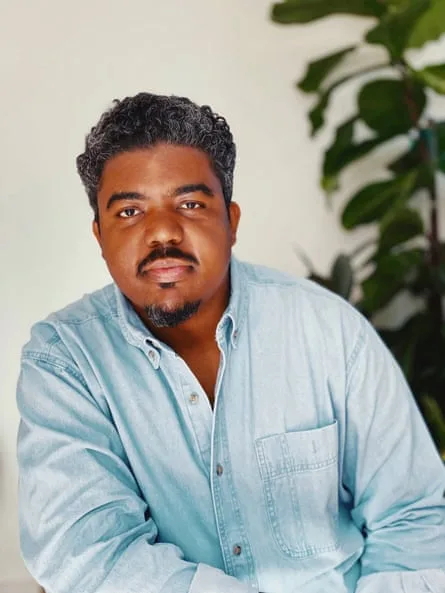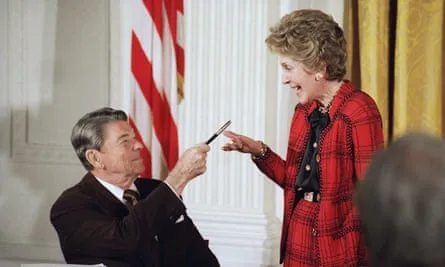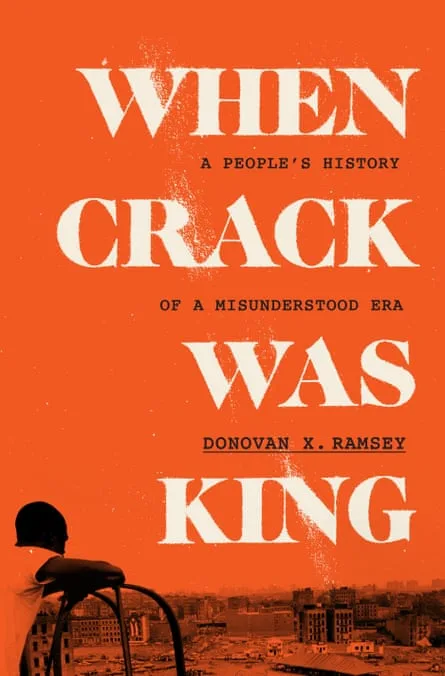There were times when Donovan X Ramsey thought writing this book was going to kill him. As he struggled through each chapter, “the story fought back”, inflicting brain fog, insomnia, stomach pains, heart palpitations. “On more than one occasion I visited the ER, certain that I was dying,” the 35-year-old writes.
But he got it done: When Crack Was King is a panoramic social and political history of the crack cocaine epidemic that destroyed countless Black lives in the 1980s and 90s. Ramsey came to realise that his illness was not due to “book jitters” or a mysterious medical condition. After visiting the 10 cities hardest hit by crack and interviewing hundreds of former addicts, crime victims, community activists, ex-prisoners, journalists, police officers and politicians, he was manifesting classic symptoms of post-traumatic stress disorder.
“Writing is a process of making sense and making meaning so you sort of metabolise the information that you take in,” Ramsey, a journalist and author based in Los Angeles, says by phone during a trip to New York. “My body completely rejected the process. I lost 40lb because I could barely keep anything on my stomach. I was so anxious that I started having heart palpitations. And it was finishing the book which was like complete digestion of this process.”
The book’s dustjacket describes the crack epidemic as arguably the least examined crisis of American history. There has been a collective amnesia around the drug that became widespread in the 1980s, especially in low-income communities, with ruinous social and economic consequences.
People became involved in drug trafficking and other criminal activities to support their addiction or capitalise on the drug’s demand. Politicians and the media spread myths about a doomed generation of “crack babies”. Police crackdowns and strict anti-drug laws led to mass incarceration, primarily from low-income communities of colour.
Ramsey reports from the cities that were at the frontline – Newark, Washington, New York, Oakland, Atlanta, Los Angeles, Detroit, New Orleans, Memphis and Philadelphia – and weaves a narrative through four people who lived it. They are Elgin Swift, the son of a crack-addicted father who turned their home into a “crack house”; Lennie Woodley, a former crack addict and sex worker; Kurt Schmoke, the longtime mayor of Baltimore and an early decriminalisation advocate; and Shawn McCray, basketball prodigy and co-founder of the notorious Newark, New Jersey, trafficking group the Zoo Crew.

Each struck a nerve with Ramsey, who was born in Columbus, Ohio, in 1987 and, by the age of five or six, had heard the word crackhead countless times, usually from other children. One of his earliest memories is of a neighbour, Michelle, whom he did not meet but encountered through the whispers of others: sad, a mess, a crackhead.
He recalls: “I have these distinct memories of going to bed at night to the sound of her playing one particular Patti LaBelle record on a loop. The song is If Only You Knew and the lyrics are in part, ‘You don’t even suspect / Could probably care less / About the changes I’ve been going through’. Even though I was maybe five, I understood on an emotional level that that she was communicating something about her life.”
Growing up, Ramsey witnessed daily the ravages of crack in his neighbourhood – and the way police responded. “My town was like a steel town where nobody talked about steel. Crack was everywhere. It’s fallout was everywhere but it was something that we avoided because of the fear and the shame of, if you looked directly at it then maybe it would gobble you up somehow.
“You had to navigate the violence that accompanied the drug trade, just being in a neighbourhood where people shot and killed each other and being afraid of the sort of random violence. But you also had to navigate then the policing that was applied like a dragnet across your communities.
“A day in the life of a child like me might be getting down on the floor because there are gunshots ringing out during dinner and then making sure that you lock everything up tight at night because you don’t want an addict to break into your house and rob you. And then the next day, going to school, being stopped by police and questioned because you could be a drug addict or a drug dealer.”
America had a glut of cocaine in the early 1980s. The drug was seen as cool, chic and glamorous and people experimented with different ways to consume it. A group of chemistry students at UC Berkeley in California came up with a recipe for freebasing cocaine using water and baking soda. The resulting substance was a highly potent form of cocaine that is smoked rather than snorted, leading to an inexpensive, immediate and intense high. It was short-lived and left the user craving more.
Crack quickly found its way into Black communities at a moment of disaffection and disillusionment in the aftermath of the civil rights movement. “People were without jobs. People were in poor housing and they didn’t see a better life ahead. Any time you have circumstances like that, people want to check out, and they chose this new drug that was still glamorous and that was cheap and super accessible with no idea of all of the devastation that would accompany it.”
An inspiration for Ramsey was The Warmth of Other Suns, Isabel Wilkerson’s masterpiece about the Great Migration of African Americans from the south to cities in the north-east, midwest and west. But those cities suffered factory closures and deindustrialisation, many Black people were left in poverty while whites fled to the suburbs.
“There’s this important context of Black folks leaving the south for more opportunity and getting to these cities and not necessarily getting that opportunity but at least getting a working-class existence, and then even that being taken away by policy decisions made by the government and then the crack epidemic being something of a fallout from that.”
Richard Nixon had run a “law and order” campaign for president in 1968 and declared “war on drugs” three years later. In between, in a diary entry from 1969, the White House chief of staff, HR Haldeman, paraphrased Nixon’s private view that “the whole problem is really the blacks”, adding: “The key is to devise a system that recognizes this while not appearing to.”
In Ramsey’s telling, another Republican president, Ronald Reagan, latched on to the war on drugs that the Nixon administration was never able to fully operationalise. He signed into law the Anti-Drug Abuse Act, mandating a five-year minimum prison sentence for the possession of five grams of crack (a sharp disparity with powder cocaine, more associated with celebrities and the middle class).
Reagan and his wife, Nancy, were behind public information initiatives that included special sitcom episodes aiming to frighten children away from drugs – but also pushed misinformation about addiction and demonised entire communities.




Ramsey comments: “The devastation of the crack epidemic was not just the drug use itself but also the government’s response to the drug use. On the policy level, the US government turned a blind eye despite knowing the fact that large quantities of cocaine were being shipped into the US. Coca leaves don’t grow in the ghetto; coca leaves are grown in the Andes, where we happen to have our hands in lots of conflicts.
“The US government wanted to fund the overthrow of governments like the government in Nicaragua and Congress would not approve that kind of meddling in a foreign government. So, very simply, we turned the other way while Nicaraguan rebels distributed cocaine into the United States and, as a result, we saw the crack epidemic really take off. The government, instead of intercepting and interceding in that drug trafficking, decided to criminalise drug possession.”
Conspiracy theorists have proposed that the Central Intelligence Agency (CIA) deliberately flooded the inner cities of the US with crack cocaine. Ramsey did not discover evidence to support that claim but found the truth to be no more consoling.
“I was not able to find a direct conspiracy of white guys in a back room saying, let’s destroy the Black community. It was actually more insidious, which is that conspiracy happened hundreds of years ago, that Black people were positioned in American society from very early on to be the Americans closest to harm. When any disaster happens, whether it’s Hurricane Katrina or Covid or crack, we are hit first and we are hit worst.”
Ramsey’s harrowing writing process coincided not only with the coronavirus pandemic but the police murder of George Floyd, an African American man in Minneapolis, and a fresh reckoning over systemic racism in the criminal justice system. Many of those seeds were planted during the crack cocaine epidemic, he argues, and many of the key lessons remain unlearned.
He explains: “There was a 100-to-1 sentencing disparity between crack and powder cocaine that was completely arbitrary. That was addressed during the Obama administration but it’s still 18 to 1. Despite all we know about the consequences of it, and about crack being the same substance, there isn’t yet enough political will to completely eliminate that disparity because there’s still so much fear.
“Part of why we have mass incarceration in the US is the policy of mandatory minimum sentences. It takes the discretion away from judges to give time to offenders based on a number of different factors. Instead it says if you do a crime then you have to get a certain sentence and that keeps people locked up. Those are crack-era policies.”
The current American president does not get off the hook. As a senator, Joe Biden sponsored a 1994 crime bill that increased mandatory minimum sentences, applied the death penalty to 60 crimes and provided money to build state prisons and hire an extra 100,000 police officers. Biden’s election as president in 2020 rested on the shoulders of Black voters.
Ramsey comments: “I don’t think the Biden administration has done enough to reverse some of the damage, at least on the federal government level, of the crack era. I don’t think Joe Biden as an individual politician has done enough to address his legacy of spurring mass incarceration and pushing awful ideas about drug addicts. It’s a complete mind fuck that his son Hunter was a crack addict at the same period that Biden was advocating for the death penalty for drug possession.
“He has to answer for that. He’s probably not going to read my book or answer for it until we make him. My hope is not that the politicians read it but that the people read it. The politicians have had their say and we know what they think and what they are prepared to do. The question is, what do we think and what are we prepared to do?”




Now America is wrestling with another drug epidemic: opioid painkillers, pushed by the pharmaceutical industry and responsible for the deaths of more than half a million people over two decades. The scourge is still tearing through rural areas, small towns and urban centres. Overdose deaths from the opioid fentanyl quadrupled between 2016 to 2021. Ramsey detects obvious similarities but also instructive differences.
“I do think the nation at large has more compassion because those drug users are white. They feel more familiar to them for that very silly reason but sadly, despite having more compassion, the people in charge aren’t smarter about what to do because they’re not looking back at the last drug epidemic. They are still allowing race and class to be this false division between people. They think that was something different that happened back then over there to ‘them’ but really it was just addiction.
“It was a generation of people going through addiction and what we should be looking at are the ways that Black and Latino people in particular invested in each other on a community level and pushed, informally, harm reduction. We should say, how can we double down on that now? What we owe the survivors of the crack epidemic is to finally get it right.”
Indeed, for all its traumas, When Crack Was King – dedicated to “the misunderstood, the marginalized and the maligned” – is also a narrative of redemption, telling of the thousands of extraordinary decisions by ordinary people that brought the crack epidemic to an end.
Ramsey reflects: “Ultimately we saved ourselves. The US government didn’t make any great intervention beyond policing and researchers point to not policing as what disrupted the crack epidemic and ultimately led to its decline but choices that young people made to not use crack, to not make cocaine their first drug that they would experiment with.
“Beyond that I point to small actions made by individuals as what kept us alive. It was grandparents taking in their grandchildren while their parents were running the streets. It was churches that did gun buybacks or gave people a roof over their head while they were going through treatment and withdrawal. It was community, even organisations like the Nation of Islam, that shut down the projects and kicked out drug dealers.
“Those weren’t big policy interventions that changed things overnight. But they kept us alive long enough for the storm to pass.”
-
When Crack Was King is out now


